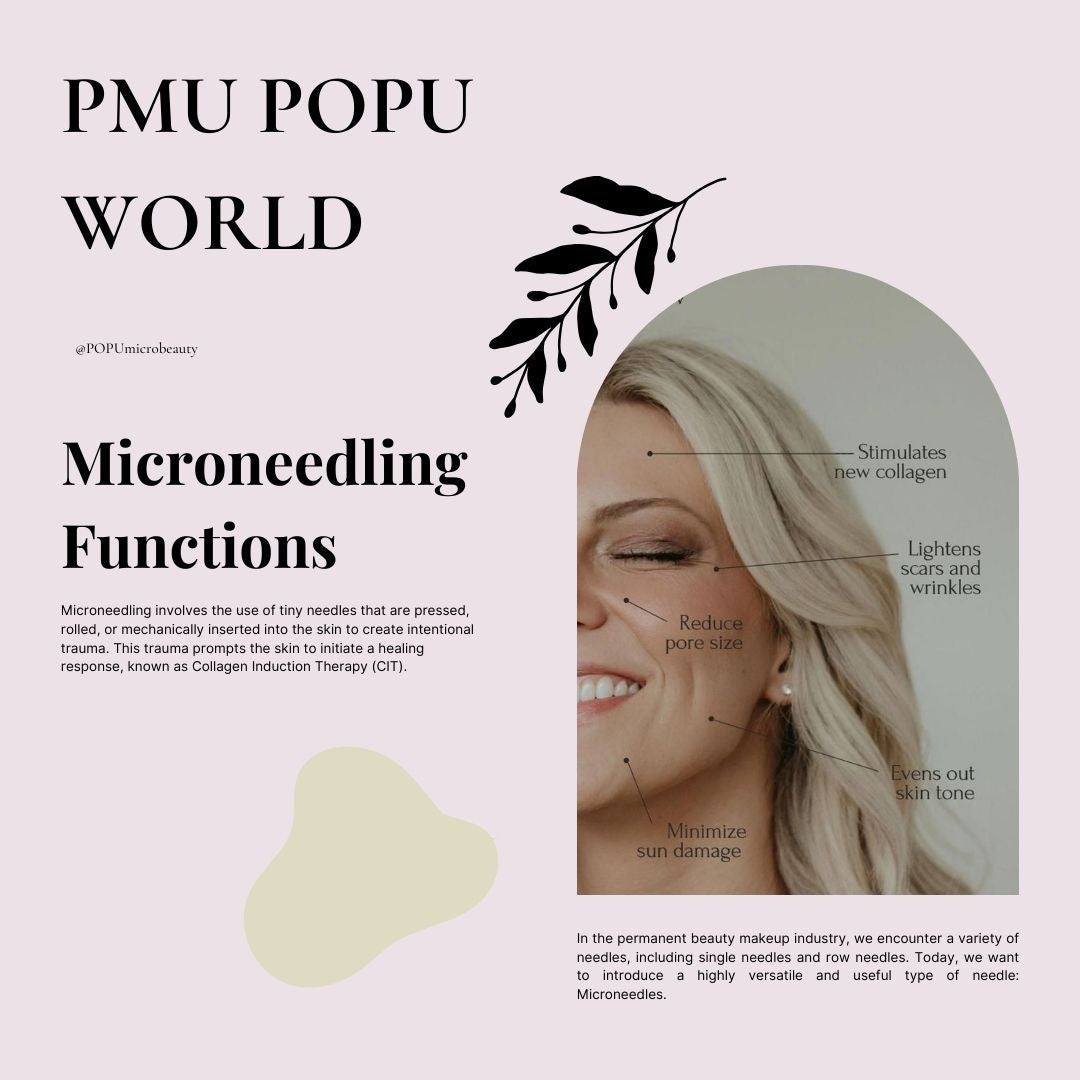The Art and Science of Microneedling: From Skin Therapy to PMU Innovations

|
1. What Microneedling Does for Your Skin: A Functional Overview 2. The Mechanism of Microneedling in Skin Therapy 3. Microneedling in Modern PMU and SMP: New Functional Insights 4. Which Microneedling cartridge is right for you? 5. What depth and speed should be used when microneedling? 6. POPU Innovations: Microneedles Designed for the Modern Artist |
1. What Microneedling Does for Your Skin: A Functional Overview

|
In the permanent beauty makeup industry, we encounter a variety of needles, including single needles and row needles. Today, we want to introduce a highly versatile and useful type of needle: Microneedles.
Microneedles typically contain multiple needle threads within a single cartridge, allowing for large-scale treatment operations to be performed at once. Initially, microneedle therapy found its primary application in the skin and beauty industry. Currently, microneedling is one of the most sought-after aesthetic treatments, and for good reason. It can enhance skin tone and texture, promote a brighter complexion, and reduce the appearance of fine lines and wrinkles by stimulating collagen production. Additionally, it is effective for treating scars and addressing stubborn concerns such as under-eye bags and festooning.

|
It can also assist with skin laxity. After having a baby, the skin around the abdomen may become looser than desired, so this can aid in tightening it. Microneedling can also be utilized for medical issues, such as various forms of alopecia. It can be quite effective for hyperhidrosis (excessive sweating), and it works wonderfully for melasma.
2. The Mechanism of Microneedling in Skin Therapy

Microneedling involves the use of tiny needles that are pressed, rolled, or mechanically inserted into the skin to create intentional trauma. This trauma prompts the skin to initiate a healing response, known as Collagen Induction Therapy (CIT). As we age, our skin shows signs of aging because the structures—collagen and elastin—that once kept our skin plump, bouncy, smooth, and lifted begin to decline. Microneedling stimulates the production of both collagen and elastin, encouraging the skin to rebuild and rejuvenate itself.
Collagen is a vital structural protein in the body that serves to bind tissues and cells together, functioning as the essential framework that maintains our overall shape and integrity. As we age, the body’s production of collagen diminishes, leading to notable effects on skin elasticity, muscle tone, and joint function.
Microneedling stimulates your skin to produce more collagen and generate new skin cells. The tiny pinpricks create microtrauma, triggering the skin’s healing response. This encourages macrophage cells to produce new collagen and elastin-rich tissue. As a result, the new skin tissue appears more even in tone and texture, while also being firmer and brighter.
Microneedling involves the use of tiny, sterile needles that are thinner than an eyelash, which are inserted into the skin to create microchannels. These needles can vary in depth to skin, ranging from 0.2 mm to 8 mm, depending on the thickness of the skin in different areas of the body. For delicate areas like around the eyes, a depth of 0.2 mm is often used, while thicker skin, such as areas with stubborn stretch marks, may require an 8 mm microneedling device.
Microneedling can also be viewed as a form of drug delivery or ingredient delivery therapy. The tiny punctures created by the needles serve as channels that allow active ingredients or medications to penetrate deeper into the skin. This targeted approach not only enhances the precision of the medication's delivery but also increases its effectiveness.
3. Microneedling in Modern PMU and SMP: New Functional Insights
Based on this principle of drug delivery, it is logical to consider that this model can assist in treating certain Permanent Makeup (PMU) and Scalp Micropigmentation (SMP) techniques. Microneedles can be inserted into the skin to create microchannels, allowing for the injection of pigments to achieve various beauty and makeup effects.
Scalp Micropigmentation (SMP) aims to create the illusion of a full head of hair by mimicking the appearance of hair follicles on the scalp. This process involves applying specialized pigments in tiny, layered dots of different shades of black on the scalp.
Lip blush works in the same way: For lip blush tattooing, using a single needle and a quick, consistent hand motion, we can create a series of dots as opposed to a solid line as the needle goes in and out of the machine, penetrating the skin.
Therefore, the microneedles are fully compatible with SMP and PMU.
Microneedles are not only effective tools for SMP and PMU projects but also offer significant advantages. Each ink cartridge typically contains multiple needles, providing artists with more options and enhancing the efficiency of SMP and PMU. Additionally, depending on the techniques used by different PMU artists, these methods can be refined to achieve even better results.
4. Which Microneedling cartridge is right for you?

|
The variety of microneedles is extensive, so let's discuss some typical needle sizes. The options include Nano, 12-pin, and 36-pin cartridges. What are the differences between them, other than the obvious increase in the number of needles? It can be inferred that more punctures from a cartridge with more needles would result in more consistent skin treatment during application.
The concept is somewhat analogous to how aggressive the treatment feels: with fewer pins, the experience can be more intense. For instance, think about it this way: if you take a single pencil and push it through a piece of paper, it will likely penetrate easily. However, if you take a stack of pencils and try to force them through the same paper, it probably won't work as effectively.
Please think about it. When you have a 9-pin or a 12-pin cartridge, the pins are relatively sparse, with plenty of space around each one. This spacing allows the skin to easily accommodate the small punctures created by the pins.
In contrast, a 36-pin cartridge has pins that are much closer together, which means there’s less skin between them. This close placement might not be ideal, especially if your goal is to resurface a scar, as having more space around each needle is beneficial.
So, when it comes to resurfacing scars, it’s advisable to opt for lower-pin cartridges, such as the 9-pin or the 12-pin. The 12-pin, in particular, strikes a nice balance between improving skin texture and promoting overall skin rejuvenation.
The 12-pin cartridge is quite powerful because the greater spacing between the needles allows it to penetrate thoroughly, making it effective for treating scars. With the ability to needle up to 2.5mm in depth, this cartridge induces collagen by reaching into the dermis. However, just because the 12-pin cartridge can reach a depth of 2.5mm doesn’t mean that it should always be used at that depth. It’s an excellent option for specific areas, such as a chicken pox scar, but in fact, doing so would be quite challenging, as some areas of the face, like the forehead or around the eyes, are very thin. Therefore, while the cartridge has the capacity to needle at 2.5mm, you will need to adjust the depth on your pen’s dial for different areas.
The 36-pin cartridge is a high-pin choice, which can further enhance product efficiency. 36-pin cartridges can work for most projects.
The Nano Round Cartridge is ideal for regular use. It primarily targets the top layer of your skin, allowing your products to penetrate more effectively and helping to eliminate the buildup of dead skin cells that can make your complexion look dull. A Nano cartridge has a maximum depth setting of 0.25 mm and can be used in conjunction with serums. This cartridge operates within the epidermis.
If you want to avoid any possibility of bleeding, sticking with a Nano cartridge is a great choice. Nano cartridges are painless, and afterward, your skin will have a healthy glow.
5. What depth and speed should be used when microneedling?

|
Depth and speed are influenced by various factors, primarily the specific area and characteristics of the skin being treated. For example, when addressing stretch marks on the buttocks, it's important to consider that the skin in this area is generally thicker than that on the face. As a result, you can increase the depth to the maximum level.
When it comes to speed, it’s advisable to start slowly. Begin with a low speed to check if the pen gets stuck during the procedure. If it does get stuck, try reducing the speed to see if that helps. If the pen operates smoothly, you can gradually increase the speed.
Be sure to record the speed and depth settings that work best for different areas of the body for future reference.
When making sure depth and speed, it's important to consider your face or the specific area you are treating. Additionally, there's a third factor to take into account: your own movement speed with the pen. This vital aspect can't be adjusted with settings; instead, it will develop as you gain experience using the pen. As you find your rhythm while gliding, you'll notice how it correlates with both depth and speed.
If you want to microneedle at 2.5mm, its deepest, this means the needles need to travel a longer distance than if they were set to 2.5mm depth.
When you set the speed to the fastest with the deepest penetration, you may notice that high speed and deep settings do not work well together. The deeper you go, the slower you should set the speed because the needle pins need sufficient time to retract. Moving the pen too quickly at a deeper level can result in scratches on the skin. This is where the third factor, you.
As you penetrate the skin more deeply, it is essential to move the device carefully, as the skin's surface can be uneven and the depth can vary. At shallower depths, you can move the pen much faster, allowing for quicker punctures without causing scratches.
The deeper settings on the pen, correlating better with slower speeds, work not simply due to providing more time for the needles to travel up and down, but also for the third factor, which is the human element. When you are stabbing yourself deeper, typically you are moving slower, and how fast you move the pen around does correlate to how fast you set the pen.
6. POPU Innovations: Microneedles Designed for the Modern Artist
POPU brand has introduced a POPU microneedle that is highly effective for skin treatments, permanent makeup, and scalp micropigmentation (SMP). No matter the project, you can find a suitable model that meets your needs. With over ten years of experience in research and development, POPU is dedicated to making a significant contribution to aesthetic artists.



코멘트